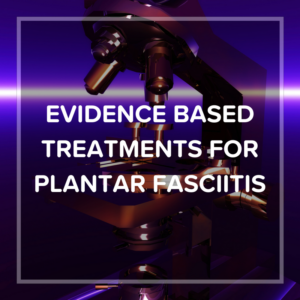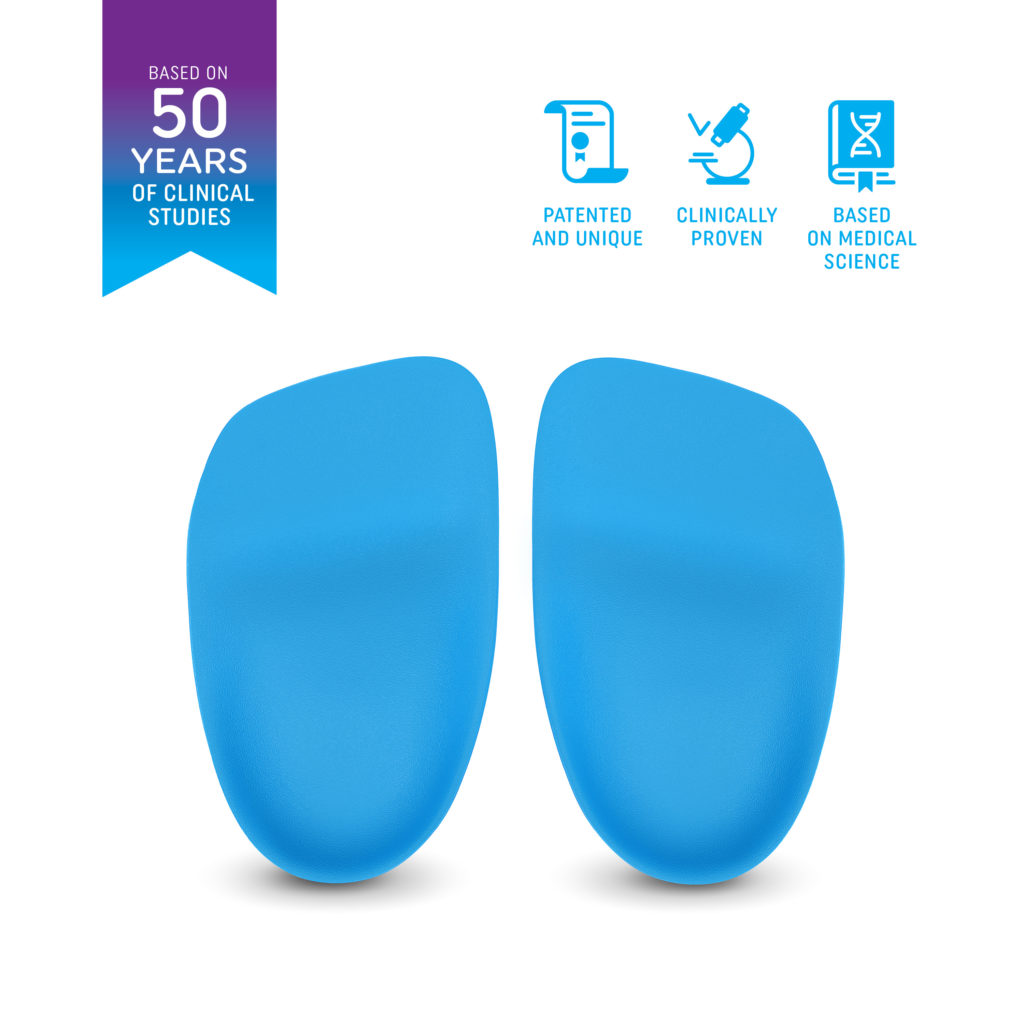 There’s plenty of anecdotal evidence for most Plantar Fasciitis treatments. Everyone has a cousin or friend of a friend who swears by a particular way of banishing heel pain.
There’s plenty of anecdotal evidence for most Plantar Fasciitis treatments. Everyone has a cousin or friend of a friend who swears by a particular way of banishing heel pain.
But what does the evidence say?
While anecdotes and recommendations from friends and family shouldn’t be discounted–especially if the treatment is affordable and low risk–it’s also important to know how different treatments stack up in clinical studies and peer-reviewed journals. Looking at this evidence, alongside recommendations from people you know and love, can help you make the best decision for your foot health and healing.
Evidence-Based Plantar Fasciitis Treatments
In this article, we’ll review some of the treatments for Plantar Fasciitis and heel pain that are backed by the most high-quality evidence. Each of these treatments has been legitimized by rigorous double-blind, peer reviewed studies and documented by scientists, doctors, and podiatrists in journal articles and highly regarded publications.
Since expense and invasiveness are usually the biggest deciding factors in treatment options, we’ve divided these evidence-based treatments into inexpensive and noninvasive, moderately expensive and minimally invasive, and expensive and invasive categories.
Inexpensive, Non-Invasive Treatments Backed by Evidence
Surprisingly, some of the simplest, least expensive treatments for plantar fasciitis are also backed by the most evidence.
That’s why the overwhelming majority of podiatrists and doctors recommend trying these proven, effective treatments for heel pain before moving onto more expensive options. Numerous studies, including research published in American Family Physician, show than 90 percent of patients can resolve their Plantar Fasciitis using only noninvasive and conservative methods.
Orthotics

The effectiveness of orthotic inserts is heavily debated. But evidence like Blake and Denton’s review of orthotics’ effectiveness published in the Journal of the American Podiatric Medical Association show that orthotics generally have 70%-90% effectiveness. And this study published in the Journal of Foot and Ankle Research shows that even non-custom orthotics can reduce the load on a damaged arch by 34%.
It’s important to keep in mind that not all orthotics are created equal. A double-blind study conducted by the University of Iowa found that Heel Seats, with patented Fascia-Bar Technology, are twice as effective as a leading orthotic insert. Heel Seats lift and realign the plantar fascia, target pain with acupressure, and cushion the heel for pain relief.
Stretching and Massage
Dr. Emily N. Schwartz’s review of different plantar fasciitis treatments confirmed that stretching and massage are two of the most effective at-home treatments for plantar fasciitis.
Stretches that improve flexibility and strength in the arch, Achilles tendon, ankle, calf, and legs can help the arch and supporting systems bear weight properly, and distribute impact. Massage can help improve blood flow to the injured area as well as break up scar tissue and adhesions.
Taping and Splinting
Dr. Podolsky and Dr. Kalichman’s review of several clinical trials and studies showed that taping is an effective short-term treatment method plantar fasciitis. Taping helps relief pain, apply soothing pressure with a gentle stretch, and stabilize the arch.
Splinting, similar to taping, helps keep the foot flexed in a mild stretch to reduce the morning pain and stiffness that is common with plantar fasciitis. In one study published by Clinical Orthopaedics and Related Research, 68% of participants improved their plantar fasciitis pain by using a night splint. In other studies, participants have reported struggling to use night splints consistently because of the hard brace. In these situations, Sock Night Splints can be a softer, but still effective solution.
Icing
Icing is a tried-and-true technique for many different types of pain relief–not just plantar fasciitis! Researchers from the Department of Physical Therapy at Loma Linda University showed that cold therapy (icing) was very effective in relieving pain and even reducing the thickness of the plantar fascia (one of the telltale signs of plantar fasciitis!).
Moderately Expensive, Minimally Invasive Treatments Backed by Evidence
For about 10% of people, at-home treatments for Plantar Fasciitis are not effective. If conservative treatments aren’t working after 9 months to a year, it may be time to consider moderately expensive and minimally invasive treatments backed by evidence.
These treatments are generally less than $200 per treatment, depending on your insurance coverage, show a great deal of promise in studies and clinical trials, and require minimal downtime.
Radiation Therapy

Radiation therapy uses a very low dose of radiation (similar to an X-ray) to This therapy is also on the lower end of cost, has minimal side effects and risks, is simple and non-invasive, and is not painful.
A key study by Dr. Robert Michael Hermann, MD, showed that radiation therapy can be a very effective non-invasive treatment method for plantar fasciitis patients. A 2012 study by the American Society for Radiation Oncology confirmed that 80 percent of study participants reported complete pain relief after radiation therapy, and 64 percent were still pain free after 48 weeks.
Ultrasound Therapy
Ultrasound therapy uses sound waves to break up tissue, improve blood flow, and reduce inflammation in painful feet and heels. The procedure is easy, quick, and relatively painful.
Evidence from several studies shows that ultrasound therapy can improve heel pain by up to 90%, including a 2013-2014 study conducted by Advanced Medical Imaging that followed 65 patients with chronic plantar fasciitis who used ultrasound therapy.
Intracorporeal pneumatic shock therapy (IPST):
This newer therapy is inexpensive, minimally invasive, and shows a great deal of promise in treating Plantar Fasciitis. IPST uses a small probe that emits shock waves to break up heel spurs. It requires local anesthesia, but minimal downtime. One double-blind clinical study conducted by the medical faculty at Mustafa Kemal University showed a 92% success rate in pain reduction with IPST.
More Expensive Medical Interventions Backed by Evidence

These evidenced-based methods for treating plantar fasciitis can be very effective, but are usually only recommended after more conservative or less expensive methods have been exhausted, because of the recovery time and expense involved:
Topaz Surgery
Topaz Surgery, or Topaz Coblation therapy, uses a tiny wand to make a few dozen holes in a grid pattern over the plantar fascia. As these holes are made, the wand releases small amounts of radio wave energy to destroy and remove bits of tissue to break up scarring and encourage a healing response.
Either local anesthesia or sedation may be used. And while recovery time is much easier than surgery, a walking boot and orthotics should be used, and total recovery time takes 4-6 weeks.
Topaz surgery has been approved by the FDA since 2002, and a study by Department of Orthopaedic Surgery at Singapore General Hospital showed that Topaz is a very effective medical intervention for plantar fasciitis. A study published in Foot and Ankle Surgery in 2016 showed that Topaz has an 80% success rate (similar to traditional surgery).
Plantar Fasciitis Surgery
While surgery is a big decision, it can be a good choice for individuals whose heel pain is chronic or does not respond to conservative treatments. Studies conducted by doctors and researchers at the New Britain General Hospital and the Center for Orthopaedic Care, among many others show success rates of 80% to as high as 96%, with few complications.
While surgery does require more downtime and recovery time, the evidence is clear that this last-resort is generally extremely effective.
You have plenty of choices when it comes to how you will treat your heel pain. But the most important deciding factors in getting you back on your feet should be evidence of effectiveness combined with your own unique health needs!
Whether you’re able to resolve plantar fasciitis using conservative treatments like orthotics and stretching, or need to have plantar fasciitis surgery, the goal is the same: helping you walk, move, and enjoy life without pain.




Thank you